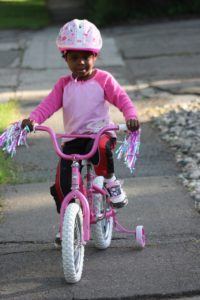Month: November 2018
With the holiday season fast approaching, many of us are beginning to think about the gifts we need to buy and what we hope to receive. It’s easy to get caught up in the latest trends of toys and technology, but one gift that keeps giving are books. Yes, books! Books may seem old-school to a few, but understanding the gift and power a book has is anything but boring. Reading books aloud to children offers many benefits to their development: books allow for more exposure to language, can increase a child’s vocabulary, and can increase a child’s imagination. Reading books early in life can help create a love of reading, which can last a lifetime.
There is always a new adventure to find behind every book. When children are read to regularly, they often have a larger vocabulary, understand more complex words, and have a better understanding and use of grammar. Reading books also helps children understand concepts such as letters, rhyming, identifying objects in pictures, asking/answering questions, and provides quality time for you and your child. When should you start reading to your child? Literacy skills can begin as early as 3-months of age, which may be seen when your child shows interest in a book by patting or chewing on it. This does not mean that parents need to begin reading to their children at 3 months of age, but it should let parents know that their child is beginning to develop literacy skills by being interested in a book. Some studies have indicated that the best time for parents to begin reading to their child is at around 8 months of age.
So, let’s talk about some great books and where to find them.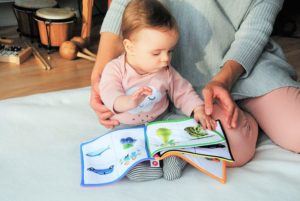
Beginner Readers-under 12 months through toddlers
A fan favorite is of course the bedtime story “Goodnight Moon” by Margaret Wise Brown, who tells the story of a bunny saying goodnight to everything around it. Additional books may include the beloved Dr. Seuss books such as, “Oh, the Places You’ll Go”, “The Cat in the Hat”, “Green Eggs and Ham”, “One Fish Two Fish”, etc.; the list of Dr. Seuss books goes on and on! More books for beginner readers may include “Curious George” by Margaret Ray, “Goodnight Gorilla” by Peggy Rathman, “Brown Bear, Brown Bear, What do you see?” by Bill Martin Jr. and Eric Carle, “The Very Hungry Caterpillar” by Eric Carle, and “Guess How Much I Love You” by Sam McBratney and Anita Jeram.
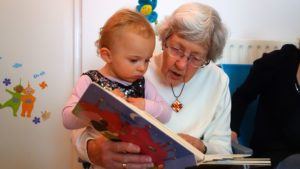
Pre-school and Kindergarten Age Readers (age 4+)
Some great books for slightly older children include: “Clifford the Big Red Dog” series by Norman Bridwell, “If You Give a Mouse…” series by Harper Collins, additional Harper Collins books such as “If You Give a Moose a Muffin”, Dr. Seuss books, “Little Critter…” series by Mercer Mayer, “Pete the Cat” series by Eric Litwin, and Berenstain Bears” by Stan Berenstain and Jan Berenstain
Elementary Age Readers: 1st Grade and Above
For children that are in the 1st grade or higher-grade levels, some books that they may enjoy include: “Magic Tree House” by Mary Pope Osbourn, “Junie B. Jones” by Barbara Park, “Magic School Bus” by Joanna Cole, “Dog Man” by Dav Pilkey, and “Captain Underpants” by Dav Pilkey.
Where to Find Books?
Books can be found in many different stores and online. The price of the book you are looking for may depend on where you buy it. Stores like Walmart, Barnes and Nobles, Half Price Books, and Target typically offer a larger selection of books at a reasonable price. Nowadays, it is easy to find and buy the book you are looking for online; sites such as Amazon offer convenient searches to find exactly what you want and are also reasonably priced. Parents can also buy books directly from the author’s or publisher’s website.
Buy a Book, Give the Gift of a Lifetime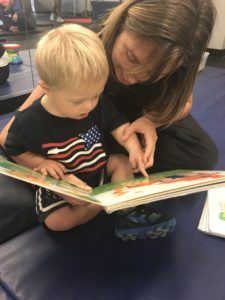
Books and the ability to read are gifts that lasts a lifetime. Books improve vocabulary, imagination, and literacy skills that will continue throughout a person’s life. As the holiday season approaches, consider getting your child or children some awesome books and open them up to a whole new world. A new adventure awaits behind every page! Happy Reading!
“The more that you read. The more things you will know. The more that you’ll learn. The more places you’ll go.”-Dr. Seuss
Find more books from pre-k through grade 9! https://shop.scholastic.com/parent-ecommerce/featured-shops/books-by-grade.html
If you have questions about your child’s development, visit ABC Pediatric Therapy Network’s website at https://www.abcpediatrictherapy.com
Read More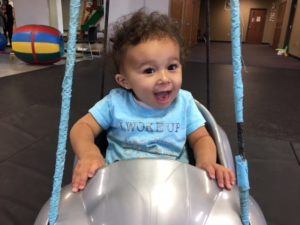
| By 6 Months | · Does not laugh or squeal · Does not look toward new sounds · No eye contact with parent |
| By 9 Months | · Has limited or no babbling |
| By 12 Months | · Does not point to objects · Does not use gestures such as waving |
| By 15 Months | · Does not have “first” word · Does not respond to own name |
| By 18 Months
| · Does not use at least 6-10 words consistently · No imitative skills (gestures or verbal) |
| By 20 Months | · Does not follow simple directions |
| By 24 Months | · Has a vocabulary of less than 50 words · Has decreased social interactions · Not combining words |
| By 36 Months | · Strangers have difficulty understanding what the child is saying · Short utterances only; limited conversational skills |
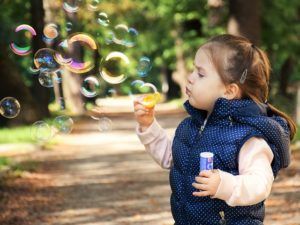
If you have questions about your child’s development, visit our website at https://www.abcpediatrictherapy.com
Written by: Christina Sanford, MA, CCC-SLP
Read More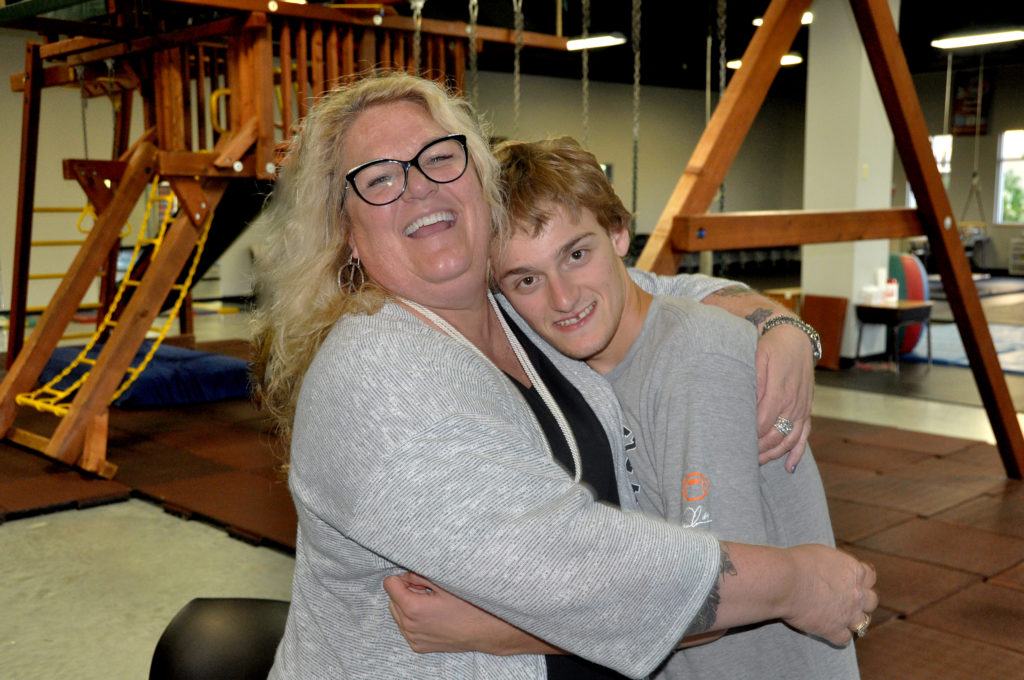 The first time Jakob had to have blood drawn, it took three of us to hold him down. He kicked, he screamed, and he fought to get free. It was a traumatizing event for both of us. It felt so very wrong and the guilt was immediate, deep and torturous. He didn’t understand what we were doing or why. I’ll never forget the look of betrayal, confusion, and the loss of trust in his eyes. It was my job to keep him safe and out of harm’s way and in that moment, I was failing. I wasn’t just failing; I was the one inflicting the pain. I couldn’t help but believe there was a different way.
The first time Jakob had to have blood drawn, it took three of us to hold him down. He kicked, he screamed, and he fought to get free. It was a traumatizing event for both of us. It felt so very wrong and the guilt was immediate, deep and torturous. He didn’t understand what we were doing or why. I’ll never forget the look of betrayal, confusion, and the loss of trust in his eyes. It was my job to keep him safe and out of harm’s way and in that moment, I was failing. I wasn’t just failing; I was the one inflicting the pain. I couldn’t help but believe there was a different way.
In my never-ending journey to find answers and more kind and gentle ways to handle everything that comes with autism, I came across some philosophies that really resonated with me. What I model, I teach. Pain is unavoidable, but suffering is optional. Everything in life is as much fun as we make it.
The approach that I had taken on all lab experiences up to that point consisted of me putting him in the car, not talking at all about where we were going or what we were doing, taking him into a sterile room and pinning him down. I believed before we even got there that it was going to be awful, horrible and extremely painful. That was the problem. So I made the conscious decision that to no longer subscribe to that belief and that I would never jeopardize our connection, his trust in our relationship or me like that again.
About a week before Jakob’s next trip to the lab at Children’s Hospital, I got myself calm, cool, collected, and excited about how I was going to approach the whole experience. We were in his playroom, the place, and space that was designed to be “Jakob’s World.” In that room, we always did what he wanted to do in the way he wanted to do it. We played his games and we talked about what he wanted to talk about. My job was to love him, accept him, not judge him and do all of this with energy, excitement, and enthusiasm.
The trick to teaching him something new in that environment (and all environments, really) was to wait until the timing was right and then introduce the new game, idea, or experience in a way that he would enjoy. Jakob loved step-by-step, numbered lists. So when my moment came, I told him that we were going for a “quick pinch” on Saturday morning. Then I “quick-pinched” him all over like I was playing a tickle game. He thought that was pretty funny. Then I walked him through the process, modeling for him on myself what was going to happen in a very silly, animated, excited, dramatic way.
1. You’re going to stick your arm straight out. (I stuck my arm out while he watched.)
2. Then a quick pinch right here! (Squeezed the skin where the needle would go.)
3. Then we’ll countdown…10, 9, 8, 7, 6, 5, 4 etc.
4. And when we get to 0, “Boom!” The quick pinch is done!
5. Then we put on a Band-Aid (which he also loved.)
6. And we wrapped it up with a celebratory dance. “Yay! Awesome!! Good job!”
I did it all with so much of the type of enthusiasm that he loved and incorporated things that motivated him. He bought in and before I knew it, we were playing the game over and over again with his arm. He was totally into it. We ended up making one small change to the routine. Instead of counting down with numbers (effective but kind of dull,) we sang a song. As we sang the last note of the song, the needle would come out and the Band-Aid would go on. His song of choice was “Hark! The Herald Angels Sing.” It was perfect.
With a solid attitude on both our parts that this trip would be fun and that quick pinches were no big deal, we had a completely smooth and trauma-free experience. In the one brief moment when he glanced at me with a tinge of uncertainty, I remained solid and confident. That was all it took to keep him at ease and ready to sing. As it turned out, there were a few phlebotomists over the years who liked to belt out a chorus or two of one of the greatest Christmas carols of all time right along with us.
While we no longer sing or go through the theatrics of it all, we still have easy trips to the lab. He’s always excited to go and he’s always happy when we leave. I’m so grateful that we figured it all out and that his trust in me has remained intact.
It was such a powerful lesson that proved all three philosophies I mentioned earlier true. Now when we’re trying something new, I ask myself, “How do I want him to think, feel and act in this situation? Is that the way I’m thinking, feeling and acting right now?”
Because is it fair to ask him to do anything that I’m not willing to do myself? How can I teach him to be calm if I’m freaking out? How can I teach him to be happy if I’m mad? How can I expect him to be relaxed if I’m all tense? I can’t.
What I model, I teach. No matter where we’ve been or what we’ve done, it’s always my attitude that leads the way. Sometimes it may take more than one or two tries, but my sweet, trusting, fun-loving boy always ends up following.
Read More
The holidays are just around the corner and family and friends will be wondering what to get your child this year. With hours spent at school, popular video games and TV shows, children are sitting more and more. This year consider some of the following ideas to get your child moving and help support their development!
Gift ideas for Elementary aged children:
-kinetic sand or sand box with shovel and bucket
-make your own sensory bins: fill containers with beans, rice, water beads, etc and hide holiday items inside for your child to find
-Print your own Christmas songs with movement book such as this one from: https://www.fantasticfunandlearning.com/christmas-songs.html
-cookie/gingerbread decorating kit
-Puzzles
-velcro dart board
-bean bags – great for a variety of games such as a child sized corn hole game or large-scale tic tac toe
-social skills board game
-fine motor tools kit
-Bike
-building sets such as lego or playmobile
-swing set or single swing that can be used indoors
-playground set
-toys with latches and keys
-chalkboard/dry erase board with writing tools and magnets
-art supplies
– lacing kits
-sports kits (goal with soccer ball, t-ball set, golf set, hockey sticks and net, basketball hoop, etc)
-get creative with obstacle courses to get your child up and moving: you can wrap your own kit with balance discs or domes, hurdles, tunnels, etc. You can also use household items such as cushions and steps to set up during play time. Doing a puzzle by crossing the obstacle course to place it in, is a fun way to make your gifts even more interactive
-put a holiday spin on household favorites. For example, if your child loves playdough, you can make your own candy cane dough, put tinsel/sparkles inside of the dough, or make your own slime!
If you have questions about your child’s development, visit our website at https://www.abcpediatrictherapy.com
Read MoreNow that Halloween has come and gone, the holiday season is fast approaching. Many family, friends and parents will be wondering what your little preschooler would love to receive! We have compiled a list of fun ideas to have for your little one to unwrap that will also help promote their development.
Gift ideas for preschoolers:
-kinetic sand or sand box with shovel and bucket
-make your own sensory bins: fill containers with beans, rice, water beads, etc and hide holiday items inside for your child to find
-Print your own Christmas songs with movement book such as this one from: https://www.fantasticfunandlearning.com/christmas-songs.html
-cookie/gingerbread decorating kit
-Puzzles
-picture books
-velcro dart board or other target game
-bean bags – great for a variety of games such as a child sized corn hole game or large-scale tic tac toe
-balance beam or balance stepping stones
-blocks –wooden or lego style

-pattern block boards
-wiki stix
-helping hands fine motor tool set
-rhythm instruments: keyboards, xylophone, maracas, tambourines
-large and small balls for kicking, throwing, catching
-tricycle
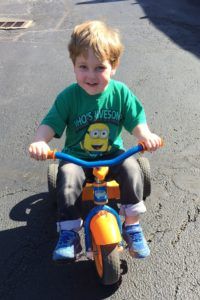
-tunnels
– Plastic bats and balls or bowling set
-art supplies such as non toxic paints, crayons, chalk, stamps, etc.
Feel free to get creative and put a holiday spin on household favorites. For example, if your child loves playdough, you can make your own candy cane dough, put tinsel/sparkles inside of the dough, or make your own slime! There are a variety of recipes available online to suit your needs and your child’s preferences. Feel free to share your ideas with us at: https://www.facebook.com/abcpediatrictherapy/?ref=bookmarks
If you have concerns or questions about your child’s development, please go to our website at https://www.abcpediatrictherapy.com
Read MoreComing up to the holiday season, many parents have questions about the best toys for their toddlers. Our day to day routines have evolved to promote children spending time in “containers.” This can be sitting in a car seat, jumpers, activity chairs, long periods in high chairs, etc. While convenient and necessary, it is also important to encourage your child to have plenty of breaks from these devices and get them moving around and playing with toys that stimulate different body systems. This holiday season, consider some of the following ideas to help promote your toddler’s development:
- Wooden blocks/mega blocks
- Connecting toys such as pop beads
- Stacking peg board

- Stacking rings
- Activity tables to promote standing and cruising
- Bubbles

- Make your own sensory bins; fill different containers with beans, rice, cereal, water beads, etc and hide holiday objects to find inside
- You can make your own Candy Cane cloud dough for a themed option. Recipe here: http://www.growingajeweledrose.com/2012/12/candy-cane-clouds-sensory-activity.html
- Playground ball, soccer ball, basketball, etc.
- Art station
- You can set up a station to play with puff paint or shaving cream and “draw” with fingers; this idea works great on a mirror or flat, easy to clean table surface
- Non-toxic art supplies
- Palm grip crayons
- Large chalk

- you can make your own chalkboard table by painting an existing small table with chalkboard paint
- Easel
- Sand box with pail and shovel
- Dress up box
- Board books
- Simple jigsaw puzzles
- Musical instruments – you can look for toy versions that pair light and sound when playing the instrument
Remember not all games/toys have to be costly or expensive! Time and time again, parents say their children love playing with household items. Get creative by putting a holiday spin on toys and games your children love. Feel free to share your ideas with other parents on our facebook page….
If you have questions about your child’s development, please call us at 513-755-6600 or visit our website at https://www.abcpediatrictherapy.com
Read MoreA new little one in the family is an exciting time, especially during the holidays! Below is a list of gifts and ideas to keep in mind when friends and family are asking what to get your infant this holiday season.
Since the “back to sleep” campaign started, there has been an increase in certain diagnoses affecting a baby’s head shape and position as well as increased developmental delays in children. You have likely heard about “tummy time” being very important for your baby’s development. This is true whether an infant is behind in some of their developmental skills or if they are already doing well with their skills. It is important to get your infant out of “containers” (car seats, positioning seats, jumpers, etc) and playing freely in different positions – and especially on their tummies!*
Consider some of the following toy ideas this year to help support your infant’s development:
- Activity mat or gym


- Tummy time cushion for little ones that have difficulty being completely on their belly
- There are a variety of cute options available for purchase but you can also make your own out of long socks and rice! Just fill it up as much as you need and tie or stitch the end!
- For parents of kids with special needs – this can be a great way to make affordable positioning devices as well.
- Play pen so your child can move around
 more freely in a safe space
more freely in a safe space - Activity balls
- Bead mazes
- Stacking rings
- Shape sorters

- Wooden blocks
- Toys with mirrors
- Rattles
- Infant ring toys for grasping and teething
- Look for soft toys with light and sound to stimulate their various sensory systems
- Board or cloth books
- Activity tables for older infants starting to stand
If you have any questions regarding your child’s development, please visit our website at https://www.abcpediatrictherapy.com
*note that tummy time should always be supervised
Read MoreHolidays are a fun and exciting time of the year. Holidays can also be a stressful time of the year for both children and their parents. Children with deficits with sensory processing may have more difficulty with maintaining appropriate modulation which may lead to being overwhelmed and having more melt-downs. Keeping in mind the following strategies can help families get though the holiday season with less frustration.
· Put up Holiday decorations slowly over time. Allow your child to be part of the process of decorating so that she does not get overwhelmed with the lights, sounds, or changes in furniture set up.
· If you take your child shopping with you, try to avoid shopping at crowded or busy times. Shopping ahead of time or online might be appropriate alternatives.
· Educate extended family members about your child’s difficulties with sensory processing and let them know if there are any changes and adaptations that you will be making to traditional Holiday get togethers.
· When going to outings that may be overwhelming take your child’s comfort items and familiar toys for him to play with.
· Let your child know ahead of time what activities are scheduled. Let them know what the activity is, when it will take place, and what to expect. If possible, it may be beneficial to create a social story with pictures from previous years if possible to share with your child before an event.
· Try to stay on your normal routine: Try to be consistent with wake-up times, nap times, meal times, and bed times. Try to keep the same bedtime routine allowing time for your child to calm down before bed.

· Allow for extra rest and nap times if needed. Schedule in times for your child to have down time from scheduled activities in a quieter place.
· When going to family meals: allow for your child to eat at their typical meal time. Bring food that your child will usually eat and allow them to eat the familiar foods.
· When going to relatives/friends’ houses for get togethers it may be helpful to talk to the host a head of time to see if there is a separate place for your child to go to calm down if needed or to warm up to transition to environment.
· Dress your child in comfortable and familiar clothes. Allow the child to wear his favorite pants with a Holiday shirt, looks for clothes in the same fabric that they are used to wearing. For Holiday outfits, allow the child to wear the outfits before a holiday gathering.
· Be flexible on your expectations for traditional holiday activities. Allow for your child to stand near Santa or give him a high-5 instead of having your child sit on Santa’s lap for a photo. Let a child open only one or two gifts at a get-together and take the remaining gifts home to open at a later time.
Check out our video: Preparing your sensory child for a Holiday – YouTube
Staying flexible and making small adaptations can help you and your child have a more enjoyable Holiday season. For more information about sensory processing and development milestones please visit our website at: www.abcpediatrictherapy.com
Read MoreWith Thanksgiving quickly approaching, do not let having a picky eater impact your time spent with family and friends. ABC Therapy would like to offer you these helpful feeding strategies to help reduce the stress during your Thanksgiving meals.
- Positioning– Children perform best when their feet are flat on a sturdy surface, eating surface is at waist level, and they’re able to reach all things in front of them.
- Variety– Offer an assortment of foods, both preferred and non-preferred options, but do not force your child to finish full amounts if they are unable.
- Volume- Offer small amounts of each food option so the child does not feel overwhelmed with the quantity on their plate. Children are more likely to try one bite of a new food than a whole helping.
- Choices- Offer numerous choices based on foods provided i.e “Would you prefer the corn or carrots on your plate?”
- Separate and Make it fun– Bring supplies like divided plates, a cupcake baking sheet, fun utensils, or different utensils for each food to help separate food item options.


- Messy Play– If your child is not willing to eat the foods, encourage describing the foods (color, texture, taste, etc.) and allow messy play so they can explore and interact with the options on their own terms. An example of messy play could be utilizing various cookie cutters to make playful shapes.
- Model– Demonstrate to your child what your expectations are with each food and how they should interact with it.
- Provide Praise but not Reward– Children feel accomplished when given praise like “I like how you took a bite out of ___”, “I see that you are trying hard to try ___”, “Good job touching ___”. However, providing a treat after eating a non-preferred food is not the best option for supporting carry over and independence in the skill.
- “All Done” bowl – Provide a safe place for the child to eliminate the foods from plate when they are finished to reduce overall anxiety.
- Back-up Plan– Pack the child’s f
 avorite foods in the case they are unwilling or unable to tolerate the foods provided.
avorite foods in the case they are unwilling or unable to tolerate the foods provided.
Hopefully these food-related strategies will help reduce stress for the whole family during the holiday season! Enjoy time with your family and don’t let picky eating impact the quality of time with loved ones. For more information pertaining to picky eating or other therapy-related resources, please visit https://www.abcpediatrictherapy.com/.
Happy Thanksgiving!
Read MoreASAP, YMCA, RSVP. Acronyms are all around us, permeating our lives and activities. Sometimes we truncate words just for the heck of it, “kay” instead of “okay” or “app” instead of application. Then there’s the world of healthcare and medicine, and suddenly everything is a jumbled mess of alphabet soup. It’s hard to keep track of what all the acronyms and abbreviations stand for, so today’s focus is on AAC. It stands for Augmentative and Alternative Communication.
That’s a lot of words and letters to type; healthcare professions like the quick version “AAC” much better. As parents, it’s a lot scarier to hear another clump of letters without really understanding what it means. AAC is basically a way for individuals to get help (augment) or replace (alternative) communicatio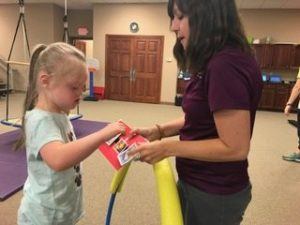 n. AAC can come in a high tech form or a low tech form.
n. AAC can come in a high tech form or a low tech form.
Low tech AAC is anything that doesn’t get programmed with a digital voice, message, or screen. There is a low tech form of AAC called Picture Exchange Communication System (sorry, it’s another acronym: PECS), which is all about requesting and then commenting using special pictures. Other low tech forms of AAC could be a book full of pictures people can point to for requesting or even a book of common people or activities in their day-to-day life. High tech AAC (think Stephen Hawkings) is about ease of access, comfort of use, and typically is used by communicators with a little more ability to understand the complexity of a more complicated system, although preschoolers to the elderly can use high or low tech AAC.
High tech AAC can be as simple as one giant, clicking button, called a switch. Some switches have 1 big button, others have a few smaller buttons. Each button holds a single, recorded message. When the communicator bumps or hits the switch, the message plays. AAC can also be as complicated as an IPad application or specialized, portable machine that’s only job is to talk. These higher tech devices come with programmed software from screen layouts of 4 to 50 full of vocabularies, subjects, word prediction, keyboards, games, search functions, access to the internet for social networking, and the list of possibilities goes on.
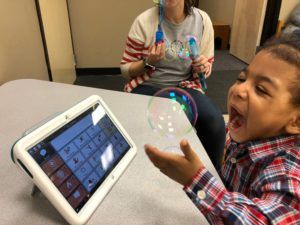
Now that we’ve had a quick background, the initial fear of the unknown should be fading…and all the questions are forming. The first thing to realize is that AAC can either augment language where it boosts, helps, and lifts a speaker’s verbal communication or it can be an alternative for them, or the third option: AAC can do both augment and be an alternative. Simply because a kiddo needs AAC doesn’t mean they don’t need their voice. Having goals in therapy to address AAC doesn’t mean your child isn’t learning to use their verbal words. In no way does it mean a child’s verbal and expressive language skills will fade, stop, or never grow. In fact, the truth is that AAC does the opposite. It makes verbal language explode. AAC gives children with a variety of diagnoses, disorders, delays, and deficits the ability to communicate with adults, teachers, and peers who may not have understood them before. It teaches children to actively seek out communication partners, to make requests, and to share their thoughts and ideas in a way that without the AAC would likely not have happened. AAC gives children opportunities. AAC gives children confidence. AAC gives children power. AAC gives children models, repetitions, and examples of more words than they would have had access to on their own, and soon, the children have heard the word enough from the AAC, that they can start verbalizing it on their own. AAC is fully customizable, modifiable, and portable. It goes where your child goes, can be used as your individual child needs, and there is no limit to the potential for their language. AAC is kind of like pixie dust…a little sprinkle can transport a child to Never Neverland: a new world of wishes, wonder, and words that they’ve never, never seen before…and you get to go along for the ride.
Read More Skip to content
Skip to content
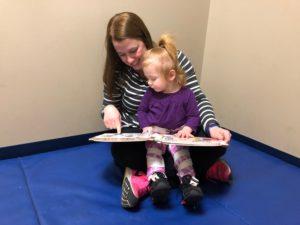
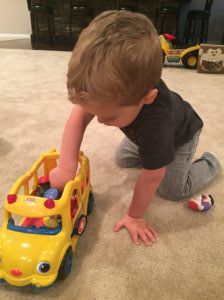
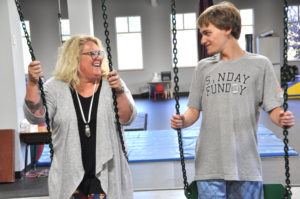


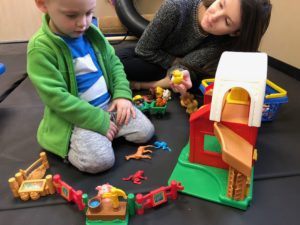
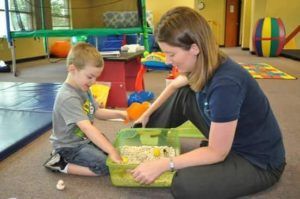
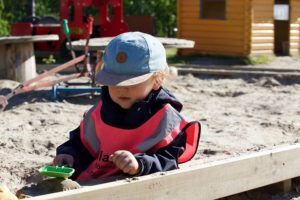
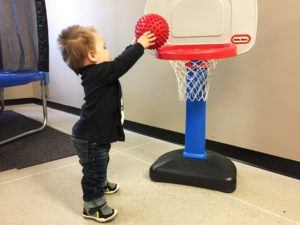
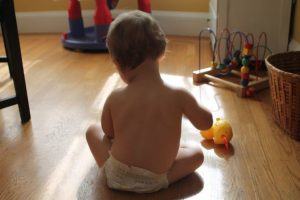
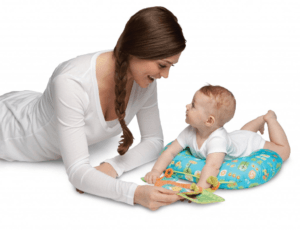
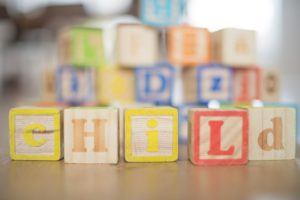 more freely in a safe space
more freely in a safe space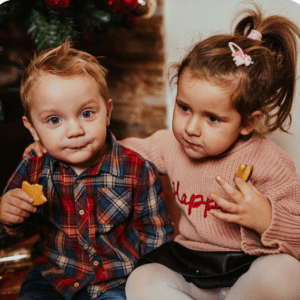
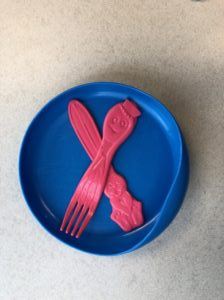
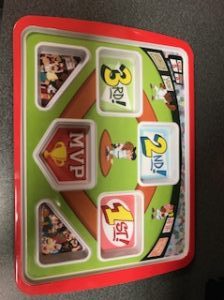
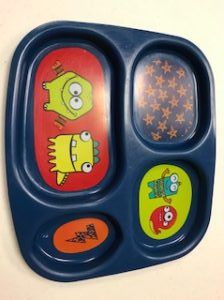
 avorite foods in the case they are unwilling or unable to tolerate the foods provided.
avorite foods in the case they are unwilling or unable to tolerate the foods provided.